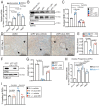Alveolar progenitor differentiation and lactation depends on paracrine inhibition of notch via ROBO1/CTNNB1/JAG1
- PMID: 34758082
- PMCID: PMC8627605
- DOI: 10.1242/dev.199940
Alveolar progenitor differentiation and lactation depends on paracrine inhibition of notch via ROBO1/CTNNB1/JAG1
Abstract
In the mammary gland, how alveolar progenitor cells are recruited to fuel tissue growth with each estrus cycle and pregnancy remains poorly understood. Here, we identify a regulatory pathway that controls alveolar progenitor differentiation and lactation by governing Notch activation in mouse. Loss of Robo1 in the mammary gland epithelium activates Notch signaling, which expands the alveolar progenitor cell population at the expense of alveolar differentiation, resulting in compromised lactation. ROBO1 is expressed in both luminal and basal cells, but loss of Robo1 in basal cells results in the luminal differentiation defect. In the basal compartment, ROBO1 inhibits the expression of Notch ligand Jag1 by regulating β-catenin (CTNNB1), which binds the Jag1 promoter. Together, our studies reveal how ROBO1/CTTNB1/JAG1 signaling in the basal compartment exerts paracrine control of Notch signaling in the luminal compartment to regulate alveolar differentiation during pregnancy.
Keywords: Alveolar progenitor; Beta-catenin; Jagged1; Mammary gland; Mouse; Notch; Robo.
© 2021. Published by The Company of Biologists Ltd.
Conflict of interest statement
Competing interests L.H., O.C. and S.C. have applied for patents related to this paper. L.H. receives research funding from Zoetis Inc. C.S. and J.W.B., are employees of Zoetis Inc.
Figures






References
-
- Asselin-Labat, M. L., Sutherland, K. D., Vaillant, F., Gyorki, D. E., Wu, D., Holroyd, S., Breslin, K., Ward, T., Shi, W., Bath, M. L.et al. (2011). Gata-3 negatively regulates the tumor-initiating capacity of mammary luminal progenitor cells and targets the putative tumor suppressor caspase-14. Mol. Cell. Biol. 31, 4609-4622. 10.1128/MCB.05766-11 - DOI - PMC - PubMed
Publication types
MeSH terms
Substances
Grants and funding
LinkOut - more resources
Full Text Sources
Other Literature Sources
Medical
Molecular Biology Databases
Miscellaneous

